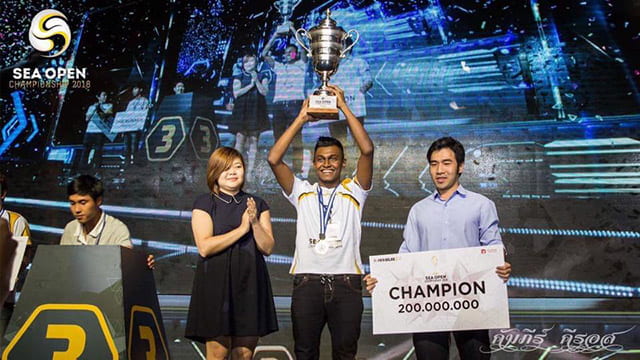Playing video games competitively for work may sound like a dream job, but two NTU e-sports players say it’s not all fun and games
by Sergul Toh

On stage, two groups of people sit hunched in front of their computers with furrowed brows, moving nary an inch except for their darting eyes and furiously clicking fingers.
Down in the audience, spectators sit at the edge of their seats as they watch the two teams battle it out on huge television monitors broadcasting the players’ onscreen actions. They are not just gunning for victory, but also a livelihood and a possible ticket to sponsorship and stardom.
Welcome to the world of competitive live video gaming – also known as e-sports – where players from all over the world go on the international stage, eyeing prize money ranging from hundreds of thousands to millions of dollars. E-sports will be a medal sport at the upcoming Southeast Asian Games.
Even the Little Red Dot wants a piece of that action, with training facilities and professional teams set up to compete on the international stage. Most recently, gaming hardware giant Razer committed $10 million to develop the local industry, which now has over 400 players specialising in several different video games, from action-strategy games in fantasy battle arenas to multi-player online football games.
Yet e-sports continues to be laced with stigma, with some brushing it off as excessive gaming, says Clement Tan, a former professional Dota 2 player and a third-year sociology student at NTU.
“Some people say you are wasting your time. Some people do not even regard it as a profession.”
The 23-year-old, who goes by the moniker InsidiousC, recalls: “Initially, most of my family treated it like a hobby that was getting out of hand whenever I was on the game for long hours.”
No child’s play, e-sports actually requires discipline to adhere to the strict and structured training schedule – not unlike training for a traditional sport.
A typical “work day” for Clement is spent at an office set up like a gaming shop, where players engage in practice matches or review videos of their games, with every minor detail in gameplay scrutinised and assessed.
All that is in preparation for game day, when their game is actually shown on huge screens, and any mistake could tarnish a player’s reputation or cost him his stab at the prize pool.
Clement trains up to 10 hours a day during his varsity breaks. Most professional players spend much more time than that, he says.
Amraan Gani, a fourth-year NTU maritime studies student who juggles his studies with semi-professional involvement in e-sports, says that the rigorous training schedule means he has to sacrifice his social life.
Clement agrees: “In a gaming setting, it is just the five of us. We get to bond with the players a lot, but I guess we do not get to bond as much with other people.”
Despite all that, e-sports is still not seen as a game worth the candle.
Clement explains: “Some people say you are wasting your time. Some people do not even regard it as a profession.”
An e-sports player at the top of his game could make millions from prize money. Amraan, in his short three-year stint as an e-sports player, already has had a taste of success – he is ranked sixth among the e-sports players in Singapore by a website that tracks the earnings of esports players in Singapore.
He was part of a three-man team to take home US$108,000 (S$142,000) after winning the largest international tournament for the Fifa Online 3 game.
But if Amraan decides to commit to e-sports full-time, he must be prepared for a monthly salary lower than what he would be able to earn in his field of study.
He concedes: “It is not a stable career, and my parents would want me to get a full-time job based on what I studied.”
For now, the adrenaline rush and the passion for the game is going at full throttle.

HEY! student writer
Sergul is an avid basketball player and a minor gym rat. He aspires to rid his procrastination habits, but let’s talk about that another day!
This story was published in the Oct-Dec 2019 issue of HEY!. To read it and other stories from this issue in print, click here.

